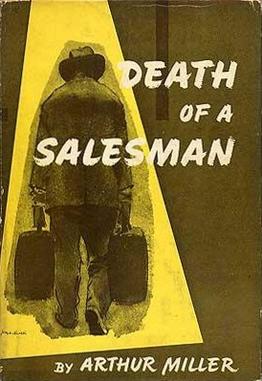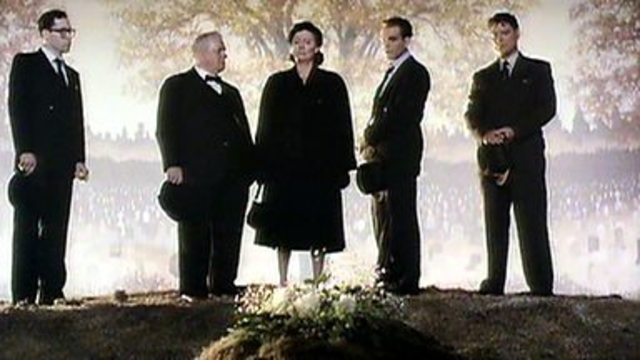This Resource is for students studying the play ‘Death of a Salesman’ by Arthur Miller in the Victorian VCE Curriculum.

Analysing Issues = Using MAPS
Ask yourself these questions using the following 4 prompts to help you analyse the issues in Death of a Salesman:
- Message = What is the author’s message?
- Audience = Who is the audience? How are they positioned?
- Purpose = What is the purpose and author’s point of view?
- Storytelling and Style Features = How are the characters portrayed? How does the setting influence the story? How does the plot shape characters? What is the form and genre? How does the form and genre influence point of view? What language is used?
How does Death of a Salesman by Arthur Miller fit the theme of “Whose Reality?”

Willy Loman, the protagonist of Death of a Salesman has been trading in deception all his adult life; in effect his livelihood has depended on it. He is depicted by Miller as a flawed character. Always a dreamer, Willy has swallowed the myth that material success represents the pinnacle of human achievement in the greatest country of the world, the USA, where anything is possible. For a salesman, ‘reality’ is whatever sells. Willy’s job has involved literally selling himself, inflating the truth, persuasion and making promises. His world implodes when the reality of his personal and professional bankruptcy becomes impossible to hide. Other members of the Loman family also thrive on self-deception and fantasy until their respective versions of reality bring them into conflict with each other and ultimately destroy the family unit.
The play’s atmospheric dimension is there to enhance the work’s narrative authority and appeal. It is a compelling representation of the dark underside of the so-called American Dream. Miller cleverly sets the scene for this stage play with his description of the Salesman’s house at the beginning of Act One as the curtain rises. The stage directions emphasise the Loman family’s vulnerability with their home small and fragile compared to the advancing urban expansion. The air of the dream, Miller says, “… clings to the place, a dream rising out of reality” (p.3 Act One).
In terms of “Whose Reality?” ultimately all the Lomans are trapped in the prison of their own subjectivity. Willy confuses the past and present, truth and lies, fiction and fact. He becomes increasingly alienated and disempowered. By the end of the play he is lost in his delusions choosing dreams over reality which descend into a nightmare.
It is worth investigating the fact that self-knowledge is a threat to the protective veneer the Lomans have constructed for themselves.
The Question of Willy’s Death in the Play

One huge issue raised by the play is the question of Willy’s death. Is Willy a tragic hero or a delusional coward? His death makes the reader question if Willy is wholly responsible for his reversal of fortune or if the world and post-war American society has failed a decent, hardworking man. The two positions are not mutually exclusive and Miller’s text supports arguments for each. It is your job to unpack these arguments in the text and decide for yourself what Willy’s downfall is due to.
Even Willy’s family have contradictory perceptions on his suicide. In Willy’s mind the decision to take his own life is a deliberate sacrifice, an attempt to salvage something from his unsatisfactory existence and put his family ahead of the game. Willy’s bleak funeral is a far cry from the grand affair he has envisaged and a telling contrast to that of his icon Dave Singleman. However, when Linda asks “Why didn’t anybody come?” to Willy’s funeral (p.119 The Requiem), Miller clearly underscores the divide between Willy’s illusions and the brutal reality of his professional world. In the final analysis ‘attention’ (p.45 Act One) is not paid to such a small man, nobody cares except his family and one old friend.
Biff intones at his father’s graveside that “He had all the wrong dreams”…. “Charley, the man didn’t know who he was” (p.120 The Requiem). While Biff is talking about Willy in this instance, all the members of the Loman family fabricate their own romanticised versions of reality that enable them to live with their failures. However, it is Happy who uncritically articulates the creed that underpinned his father’s working life, to be ‘the number one man’ (p.120 The Requiem). Happy is willing to absorb his father’s message without questioning its integrity. It is left to his faithful friend Charley to speak in his friend’s defence to Biff when he says “Nobody dast blame this man. A salesman is got to dream boy… It comes with the territory” (p.120 The Requiem).
Willy Loman is a Victim
One thing is certain; Willy in Death of a Salesman is a victim. While Willy’s story is intensely personal, Miller has made him an archetypal character whose predicament exemplifies the fallout suffered by those who cannot meet the bottom line. You have to ask yourself why Miller used the indefinite article “a” in the title of the play Death of a Salesman, suggesting that Willy is merely one of many such victims.
